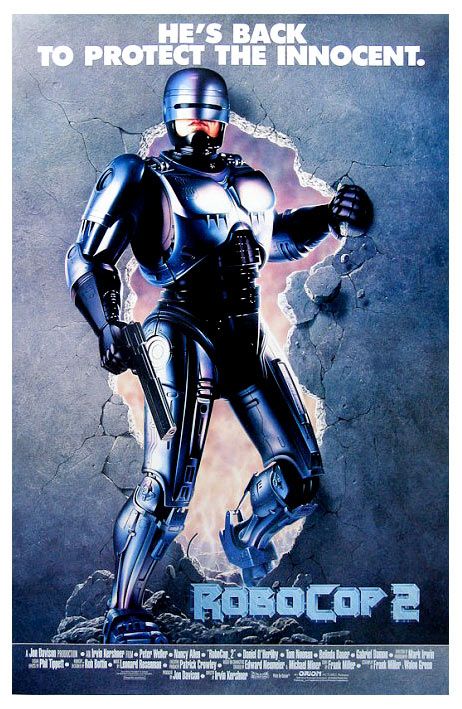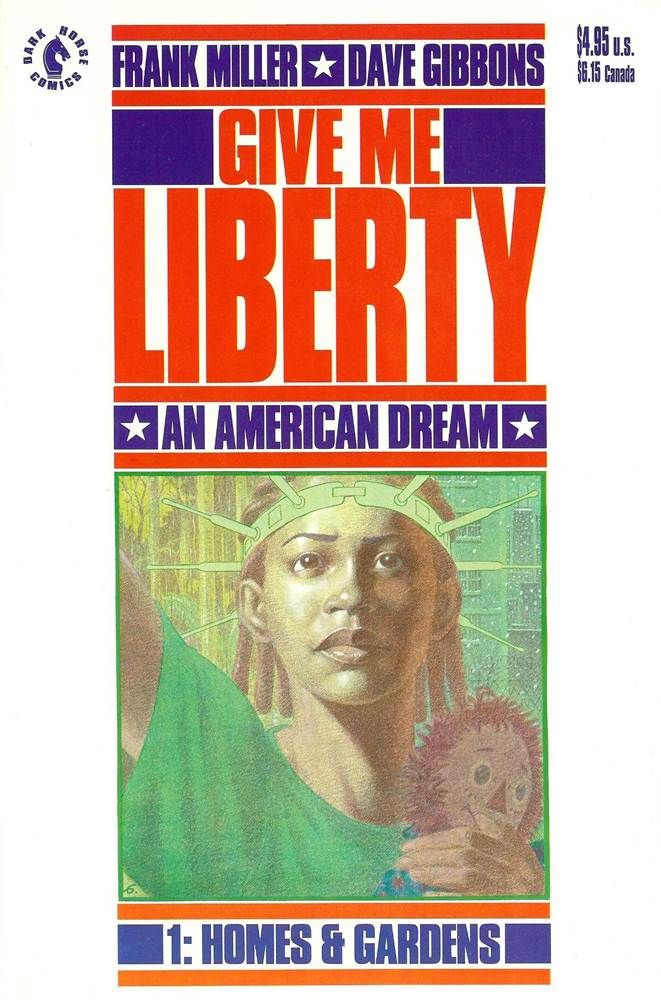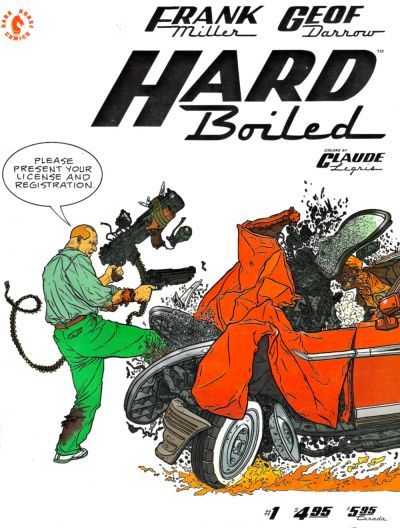ROBOCOP VERSUS THE COMICS: A FLASHBACK TO FRANK MILLER'S BIG YEAR
In 1990, director Irvin Kershner surely wasn't expecting the same level of audience enthusiasm with his new film that he had a decade earlier when "The Empire Strikes Back" delighted Star Wars fans and moviegoers of all ages. Like "Empire," this new film was a sequel, and its tone was definitely dark, but the final product just wasn't in the same league as his foray into a galaxy far, far away.
His new film was "RoboCop 2," and according to almost every critic who reviewed it upon release, it was terrible.
Roger Ebert saw the movie and identified his problems with the screenplay before finishing up with his verdict: "I didn't much like RoboCop 2...but I've gotta hand it to them: It's strange how funny it is, for a movie so bad. Or how bad, for a movie so funny." In an allusion to the original advertisements for the first RoboCop, which referred to the title character as "half man, half machine, all cop," Peter Travers of "Rolling Stone" wrote, in his review of the sequel, "RoboCop 2 is all machine, and it's all vile."
For comic book readers, the disastrous reception of "RoboCop 2" -- and the pain of actually sitting through a screening of it -- was amplified. This was more than just a sequel to a satire-laced action movie that many viewers had enjoyed. This was the Hollywood debut of Frank Miller. And it didn't go according to plan.
Frank Miller was one of the biggest names in the comic book industry in the 1980s. Once he took over the writing and the penciling of "Daredevil" in 1981, his popularity exploded, and his move to DC to write the original samurai-meets-sci-fi miniseries "Ronin" a few years later only helped to entrench Miller in the minds of comic book readers as a premier artist who was trying to push the boundaries of the medium while delivering genre-bending action and adventure. But he wasn't going to stop there.
Samuel L. Jackson Asks, Why is America so "Robo-Phobic?" in New "RoboCop" Trailer
In 1986, "The Dark Knight Returns" hit the stands, and Frank Miller became a superstar. Miller's striking reconceptualization of the Batman mythos was one of the first comic books that found its way onto bookstore shelves soon after its release and remains one of the classics of the medium to this day. It was harsh and mean and funny and filled with iconography that provided potent layers to what was basically the superhero version of a retired lawman forced to return to clean up his wild west town.
The attention garnered by "The Dark Knight Returns" lofted Frank Miller's name into the Hollywood air, and soon Jon Davison called to offer him a chance to write a screenplay. The production company needed a script for a "RoboCop" sequel, and Davison wanted Miller. The comic book writer and artist figured he could make the transition to film. Comic book readers recognized this as a chance for one of their favorite creators to make in impact on a much larger stage. But the production of a feature film is significantly different from the production of a comic book series, and Miller later admitted, in a 2001 interview with Tasha Robinson from "The AV Club," that "movies are a really sexy business, and the money's great...but it's a collaborative medium." Writing and drawing his comics for Marvel and DC, he had almost total control over the finished product. With "RoboCop 2," that just wasn't the case.
"I had aspirations of directing," said Miller, when discussing the production of RoboCop 2, "I really thought I could control the thing." But Hollywood doesn't work that way; Miller wrote draft after draft of the screenplay -- some of which reportedly written on set, after filming had begun -- and, as he puts it, "there were many hands as time went by." He realized that he was just a guy hired to do a job when it came to Hollywood screenwriting and he wouldn't be able to make the same kind of mark he had made when he was producing fan-favorite Daredevil stories or critically-acclaimed Batman comics. He soon learned that he could work in Hollywood -- and keep his sanity -- by not being possessive about writing-for-hire. "I realized at that point," said Miller, "that what I own is my comics."
"RoboCop" Commandeers Hall H, Reveals Footage & Plot Details
That year saw the debut of two brand new Frank Miller comics. Owned by him. Actually, co-owned, because in the case of both of the new series, he was writing comics that would be drawn by others. But the artists he chose to collaborate with were among the most stylish talents in the comics industry. The genesis of both projects predated the disastrous "RoboCop 2" opening, but the first issues of both new series didn't hit comic shops until after Miller was already seen as a Hollywood casualty.
That odor of failure and disappointment from the abysmal film may have influenced comic book readers' reactions to the new Frank Miller releases. Or maybe the new comics just weren't as good -- or as closely in line with audience expectations -- as Miller's more superhero-centric work of the previous decade, because though there was some initial excitement about the prospect of new Frank Miller comics, there wasn't a lot of enthusiasm after the books actually came out. But the two new series, "Give Me Liberty" and "Hard Boiled," have remained interesting and important works, and they show a Frank Miller able to collaborate effectively with his comic book colleagues and make something worthwhile and unique, even while his Hollywood disaster flamed out at the box office.
MARTHA WASHINGTON SAVES THE WORLD
In conversation with Christopher Brayshaw, as published in Fantagraphics' "Frank Miller: The Inverviews," Miller discusses the genesis of "Give Me Liberty" and provides the context for the work ethic that drove him to keep producing new work even as Hollywood was vying for his attention. "I had a mother who would work from 11 at night to seven in the morning as a nurse...very demanding work, and then would come back and raise seven kids. She slept an average of two to three hours a night. That, to me, is discipline." That self-motivation informed not only his own sense of "discipline" but also his ideas for his female protagonist. "I think that early on, I found myself very attracted to the notion that an individual could actually make a difference and overcome odds." Martha Washington, the young, black female hero of the story he would tell with artist Dave Gibbons in the pages of "Give Me Liberty," was born from that line of thinking and from a mini-vacation with Gibbons where they walked around the San Diego Zoo and talked about the concept of the American dream. "I just thought about what would you use to describe the American dream, and just saying those words evoked Horatio Alger," says Miller in his Brayshaw interview. "So I thought, 'overcoming obstacles' and the first three words I wrote down were 'poor, black and female.' Then, in a vague, many-month-long process, I started just writing scenes at random. Not a story at all. Just trying to put together a world where this character that was going to get created could exist, and to conjure up images that might trigger things."
The project that became "Give Me Liberty" was aborted for a while because the scope became too ambitious and "it was archly political, it lacked humor, it lacked adventure, and both of us lost interest," Miller told Brayshaw. But he and Gibbons eventually came back to it and turned "Give Me Liberty" into a straight-ahead story with, in Miller's words, "more of a satirical bent." It was his version of the American dream, depicted by his British colleague, and he didn't start the first issue with a superheroic ideal in full form. "I didn't want her to start out as some full-blown superwoman," Miller says. "Getting there was all the fun."
Miller's second notable comic book project of that year was the supersized magazine-format slice of ultraviolence called "Hard Boiled," which was drawn by the one-and-only Geof Darrow.
ROBOT NIXON DESTROYS THE WORLD
According to Geof Darrow, in an interview with Robin McConnell of Inkstuds, the original Miller/Darrow collaboration was going to be the Daredevil story that ended up becoming "Man Without Fear" -- the origin story eventually drawn by John Romita, Jr. But Darrow wasn't interested in doing a superhero comic that didn't actually feature costumed superheroes, and "Man Without Fear" was all about the street-clothed Matt Murdock learning to become a hero, not donning the costume until the very end.
Instead, Miller and Darrow began a very different collaboration. There was no altruistic hero at the center of this new project, or if there was, he was drenched in gore and carried a big gun. This was "Hard Boiled," and it may have begun life as a sci-fi/crime tale of one man against the world, but it ended up becoming a grand guignol of glorious excess. As Miller goes on to say in the Brayshaw interview, "I had written a straightforward science-fiction story. When I saw the artwork, I was floored. I was helpless....this was completely different than anything I had imagined [Geof Darrow] would do. The sheer excessiveness of it was shocking." As Darrow explains to Robin McConnell, there was a distinct difference between the way he perceived the project compared to Miller: "the funny thing about'Hard Boiled'was he was never meant to be-I mean, I drew him, but he was never meant to be a robot. But I drew this stuff and [Frank Miller] goes, 'My God! How can he still be alive?'"
Miller saw the images of the protagonist, a man named Nixon, physically battered by the violence of the story and tried to make sense out of it. Darrow just saw it as comedy. Comedy filtered through the Hong Kong action movies he'd been watching. In the Inkstuds interview, Darrow explains, "the first few drawings I did of [Nixon], he's got glass sticking out of him and he's all shot to hell and I'd watch those John Woo movies. I always liked the Chinese movies. In American movies, if you get in the gut, it's game over. You're dead. But in Chinese movies, the only thing slowing you down is the amount of lead that's in your body from getting shot. They walk out together, just soaked in blood."
"He gets all shot up," adds Darrow, "but Frank and me we got to make him a cyborg and then he became a robot because still there's no way. Yeah, there you go." With all the absurd details Darrow added to the pages -- exploding the page count far beyond what Miller had imagined, and not showing Miller any of the pages until each chapter was done -- Miller ended up as what he calls "the junior partner" on the project. "Hard Boiled" is a Geof Darrow showcase, with Miller tagging along for the ride.
BACK TO DAREDEVIL AND BEYOND
"Give Me Liberty" and "Hard Boiled" allowed Miller to do something different in his comics, thanks to the strong contributions of his collaborators. These two works are still worth reading today because of the strong visual components of each series, and the comedic edge present in both. The former may be more archly satiric and the latter may be more devilishly absurdist, but the humor helps keep them fresh while other more strident Miller projects -- even his notable Daredevil work of the 1980s -- hasn't aged as well.
And RoboCop 2 has a few doses of that kind of humor, but it was buried in the morass of Hollywood overproduction.
To finish out that auspicious year of Miller's career, a long-delayed project finally launched itself into the world. It was Miller's return to Marvel Comics, and his return to the world of a character that had made him famous in the industry. The book was "Elektra Lives Again," a hardcover original graphic novel written and drawn by Miller. The first project he'd both written and drawn since the smash success of "The Dark Knight Returns."
Unlike "Give Me Liberty" and "Hard Boiled," "Elektra Lives Again" played the comic book shenanigans absolutely straight. There's not much humor to be found in this sincere love letter to the mythology Miller himself had built within the Daredevil universe. And while it's not a forgotten masterpiece, it is mostly forgotten. It's rarely discussed as one of Miller's major works. But it is.
And -- you know what? -- it deserves further close reading.
NEXT WEEK: Enough with this history lesson stuff -- I will reread "Elektra Lives Again" and talk about it!
In addition to writing reviews and columns for COMIC BOOK RESOURCES, Timothy Callahan is the author of "Grant Morrison: The Early Years" and editor of "Teenagers from the Future: Essays on the Legion of Super-Heroes" anthology. More of his thoughts on comics can be seen regularly at the Geniusboy Firemelon blog.




